
MPH: To the man trying to fill Christian Horner's shoes: good luck!
Laurent Mekies arrives as Red Bull F1 team principal with a series of immediate challenges to solve and long-term issues to tackle. He'll either sink or swim, says Mark Hughes
An error-strewn start by Ferrari that handed Valtteri Bottas victory: the full story of the 2019 F1 Japanese Grand Prix
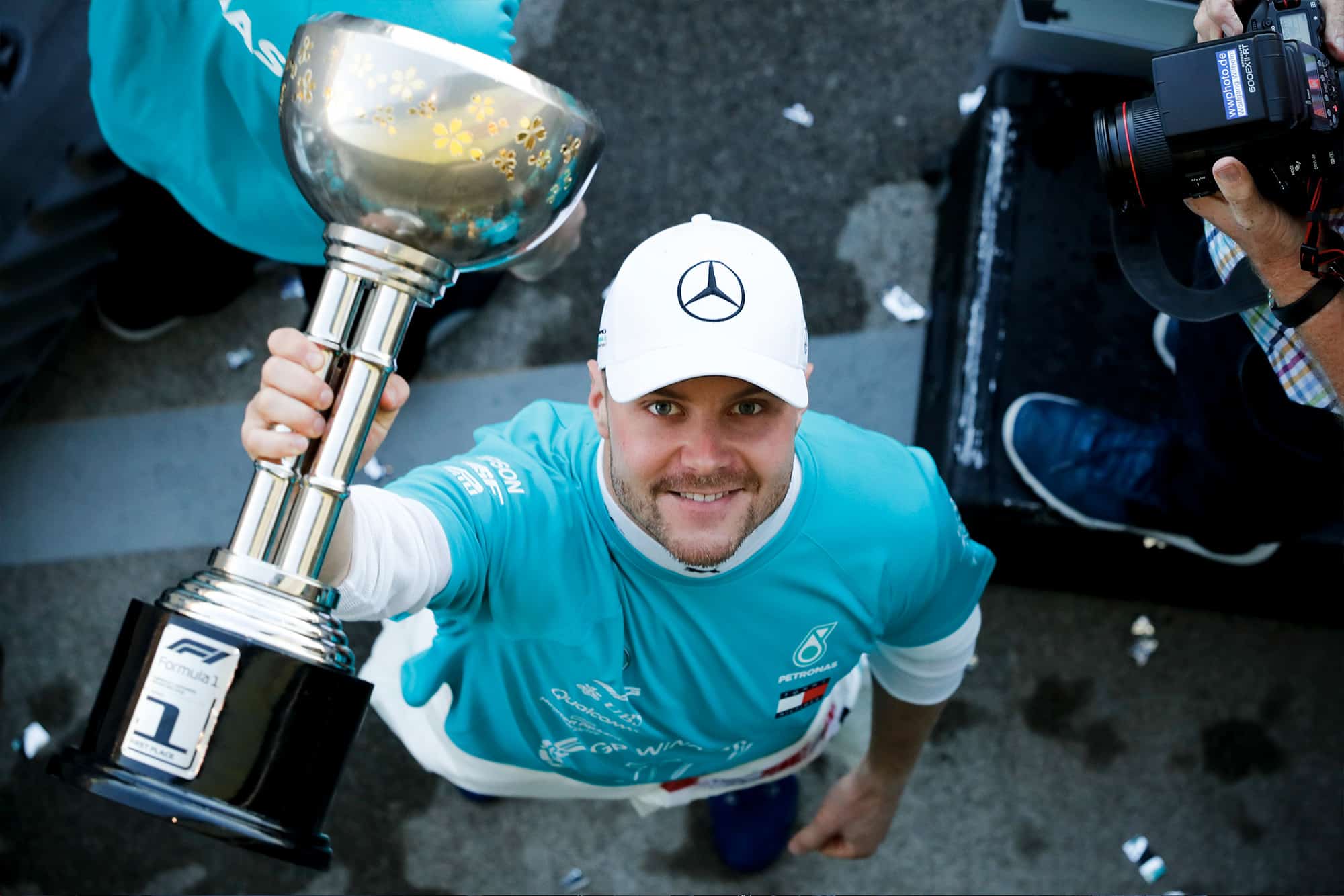
Photo: Motorsport Images
Sebastian Vettel probably still had the adrenaline of qualifying running through him as he sat on pole, awaiting the gantry lights to change. They were held on for an age and something in him triggered the urge to begin releasing the clutch, even before the lights had gone out. He moved less than a metre, then stopped.
Then the lights did finally change and he was terribly slow off the line. His false start had distracted team-mate Charles Leclerc on the front row and he too was slow away. But cool Valtteri Bottas – who’d narrowly outqualified Lewis Hamilton a few hours earlier – didn’t miss a beat and slotted himself straight into the lead. In that moment he ensured himself victory.
Yet again, Ferrari had squandered its advantage. Vettel got into the first turn directly behind Bottas but to beat the Mercedes around Suzuka the Ferrari would have needed track position over it because of its heavier tyre degradation.
A couple of seconds after Vettel’s error, Leclerc made his – colliding with Max Verstappen’s Red Bull. This would have cascading consequences on his day and compromise Hamilton’s race, with Lewis eventually losing out in a close-run contest with Vettel for runner-up.
Along the way Mercedes secured its sixth consecutive constructors’ championship.
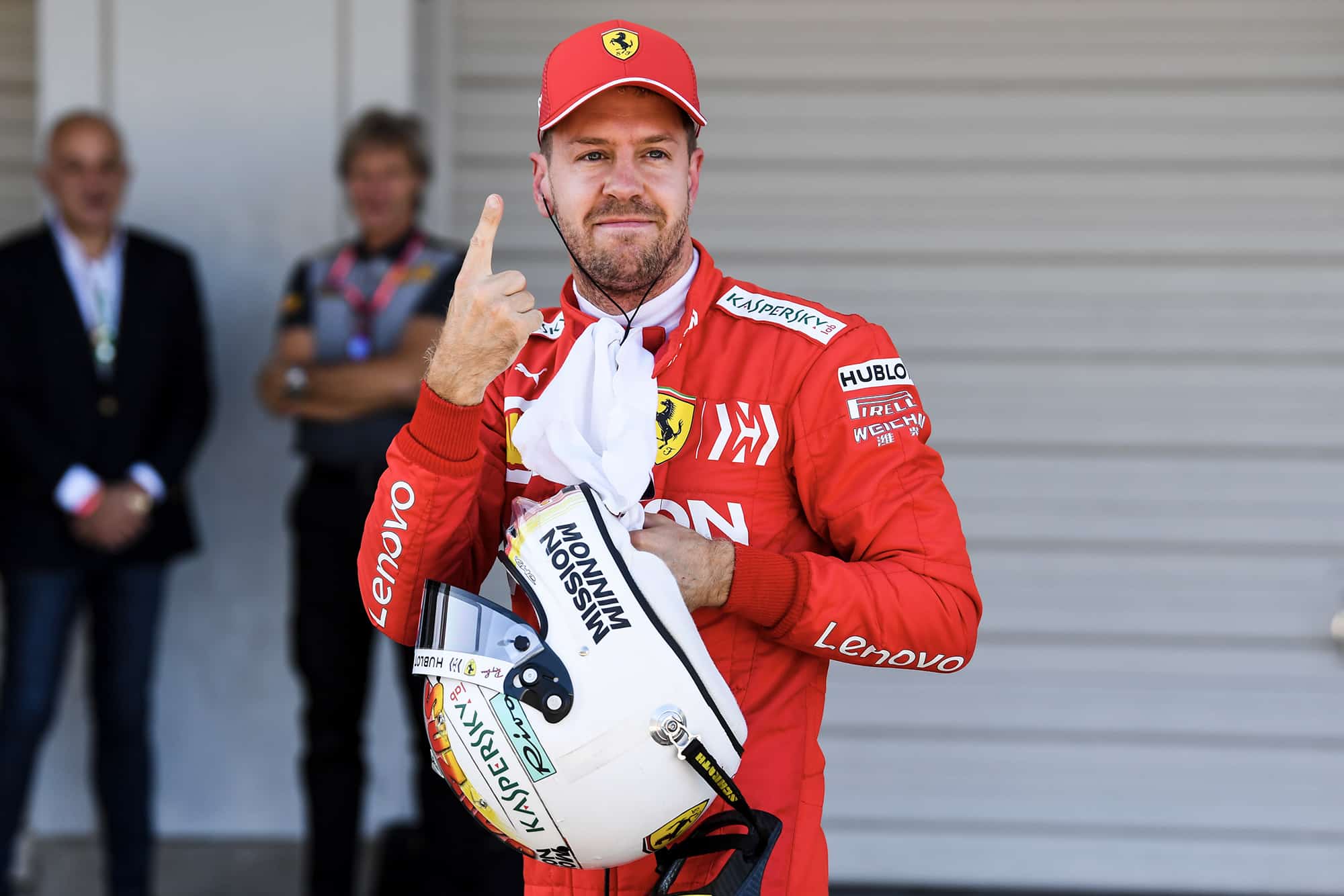
Vettel on top after Sunday morning qualifying Photo: Motorsport Images
All that was left of super typhoon Hagibis on Sunday was a gusty wind. Which turned out to be a beautiful little present to Ferrari. Going with the SF90’s sure-footedness in the wind, borne of that unloaded outboard front wing, every inch of the way, was the rejuvenated Sebastian Vettel. “No real breakthrough,” he said later. “I just had a good, clean couple of laps and the car was good.”
On Friday, Ferrari looked in no shape to threaten the Mercedes. Ok, so the cars were running old Spec One motors in low modes during practice. But that didn’t explain the 1sec deficit to them. In normal – un-windy – conditions, the Mercedes’ downforce advantage through the long corners was decisive. But as well as changing to the Spec Three engines for Sunday, Ferrari reduced the rear wing level, bringing a better balance.
Max Verstappen was ahead of Alex Albon on the grid only through having set his identical time first. This was a superb effort from Albon
Furthermore, the Mercedes – like the Red Bull – has the loaded outboard front wing, with the full depth elements that give greater direct front wing downforce and contribute to its greater overall aero effectiveness, so long as the outwash around the wheels can be adequately controlled. Achieving that control is somewhat marginal – which is the whole reason it took Red Bull half a season to switch on the RB15. It gives greater downforce than the Ferrari-style unloaded outer wing, but it’s much peakier.
The Mercedes aero team has done a fantastic job of ameliorating that trait with the W10, but Suzuka on Sunday showed that all it takes is a gusty, unpredictable wind, and the car loses some of its sure-footedness. It under-performed here just as surely as it did in the last windy qualifying we had – in Bahrain.
Charles Leclerc was somewhat shell-shocked to be two tenths adrift of Vettel, despite feeling he’d left little, if anything, on the table.
Mercedes was slightly slower in every sector, the drivers just not confident in leaning on it as hard as the Ferrari guys. Valtteri Bottas shaded Lewis Hamilton by a hundredth to go third.
They were over half a second clear of the Red Bulls which had the same problem as the Mercedes but more so and still a power shortfall despite the much-heralded new Mobil fuel for the Spec Four Honda engine. They were running significantly less wing than either Ferrari or Mercedes.
Max Verstappen was ahead of Alex Albon on the grid only through having set his identical time first. This was a superb effort from Albon on his first-ever visit to perhaps the calendar’s most demanding track, and with only two practices rather than the usual three. There was a bit of playing about with the ultimate harvest/deployment trade-off through the sessions, hence why Verstappen was complaining of no power in Q1 and Q2. But it was somewhere near its optimum for the final runs.
McLaren – another car with a Ferrari-like unloaded outboard wing – added downforce on Friday, anticipating Sunday conditions, and it seemed to pay off well as both Carlos Sainz and Lando Norris (seventh and eighth respectively) had a lot of confidence in the car on a day where that meant everything.
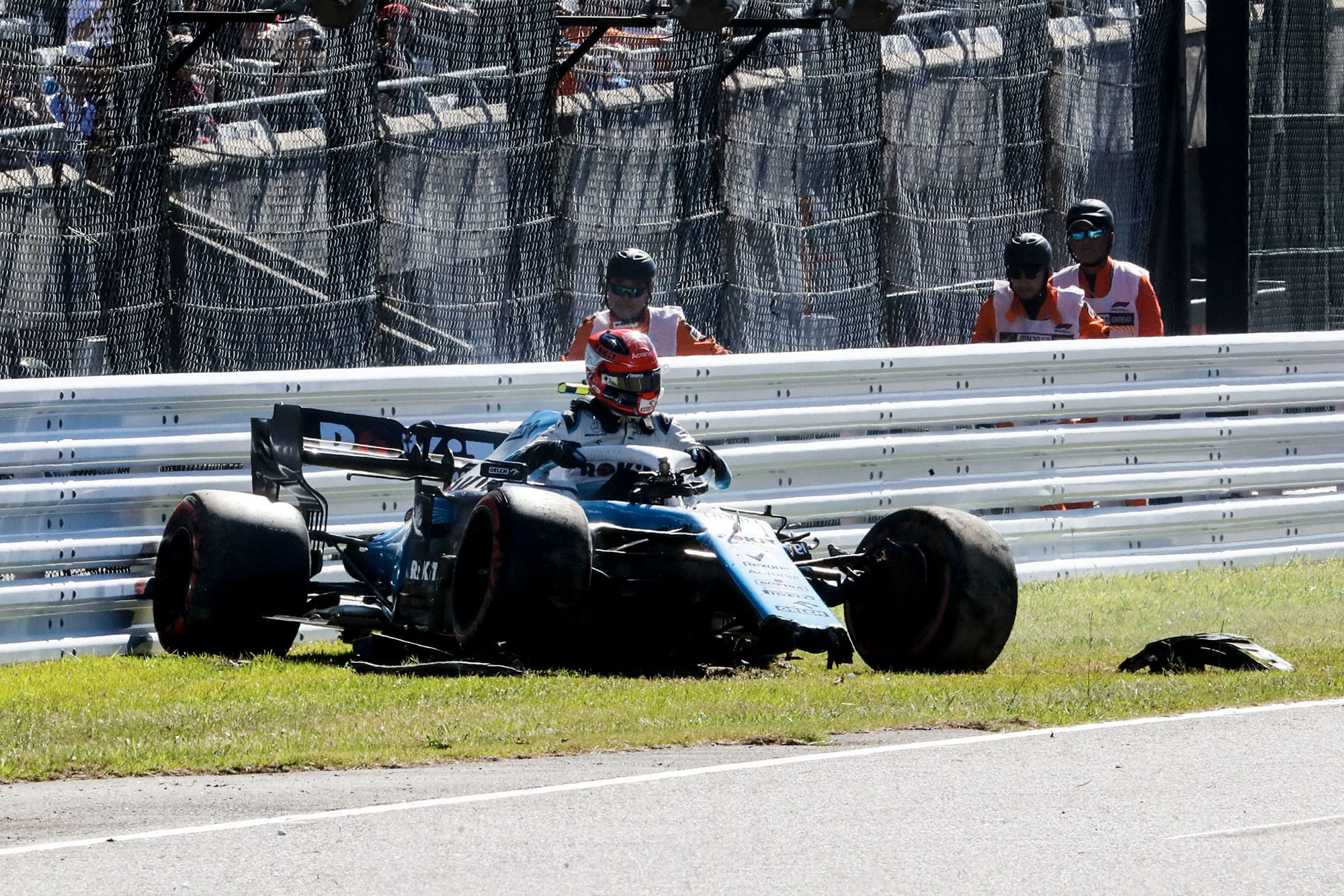
Kubica crash brought out the red flags Photo: Motorsport Images
The gusty tailwind all the way from 130R’s exit down to Turn One made some of the cars horribly twitchy, contributing to the red flag-inducing Q1 accidents of Robert Kubica and Kevin Magnussen. It also made cars with lower downforce set-ups – like the Renault and Racing Point – particularly challenging. This helped Pierre Gasly get the Toro Rosso (another unloaded outboard front wing car) through to Q3 where he qualified ninth ahead of Romain Grosjean’s Haas.
Falling out at the end of Q2 were Antonio Giovinazzi’s Alfa (faster than team-mate Kimi Räikkönen for the third successive time), Lance Stroll (who seemed more comfortable in the tricky conditions than team-mate Sergio Perez who didn’t make it out of Q1), Räikkönen, Toro Rosso’s Daniil Kvyat and Renault’s Nico Hülkenberg who suffered a hydraulics problem and didn’t get in a proper Q2 lap. It was better than team-mate Daniel Ricciardo who made a small error in the first sector, putting him out in Q1, just ahead of Perez, the Williams of George Russell and the crashers Magnussen and Kubica.
The latter had to start from the pitlane in a rebuilt car and was furious with his lot, while recognizing it was his own error that put him in the barriers before he even began his lap. “Yes, I let my rear wheel get onto the grass but things had already started going wrong before the session began,” he said cryptically. “Some decisions were taken by people who are not even here.”
He was referring to the new-spec front wing he’d tried in second practice on Friday. There was only one and Russell had tried it in first practice but hadn’t felt was any better. Kubica disagreed and was actually marginally faster than Russell in that second practice.
With Russell not using it, Kubica assumed he would have it for qualifying and race and was dismayed to find he couldn’t. “These decisions were taken without even letting me know… [The wing] gave me quite a lot of confidence and improved my feeling on the car. When you have a driver who says for the first time I can drive for very long properly this car and actually I am exploring the car, this is what every team will look to have it, but for whatever reason…”
He later explained further: “I had different power steering on Friday so the feeling on steering wheel was completely different. I was convinced that I would make this corner without problems but suddenly I ran out of road. That’s it, our boys did a fantastic job before the race and we know that they are able to do different impossible things even in rally style but unfortunately not everything depends on them.” The Williams/Kubica love affair is definitely over.

Bottas (right) sweeps into the lead Photo: Motorsport Images
The wind had died down from a few hours earlier as the remnants of the typhoon cleared out of town. This was great news for Mercedes. But there was even better to come. Within a few seconds, Ferrari’s chances in this race were blown.
Polesitter Vettel began to move before the start, stopped, then got away slowly as the lights went out – and was instantly jumped by Bottas. Vettel’s start was investigated but no penalty applied as he was still within his grid slot and stationary as the lights went out.
Leclerc’s start wasn’t great and he was passed around the outside by Verstappen at the first turn, but simply refused to recognise as much, allowing his car to run out wide to where Verstappen was always going to be. “It was my mistake clearly,” said Leclerc later. “I lost the front downforce from the cars ahead but I should have anticipated this.” They hit, spinning the Red Bull onto the run-off, damaging the Ferrari’s front-left endplate which was sparking dramatically, throwing debris into the path of the following Hamilton.
Ferrari with its front-row lockout had been in the perfect position to control things, even if the Mercedes was faster in race conditions. Within seconds that was no longer the case.
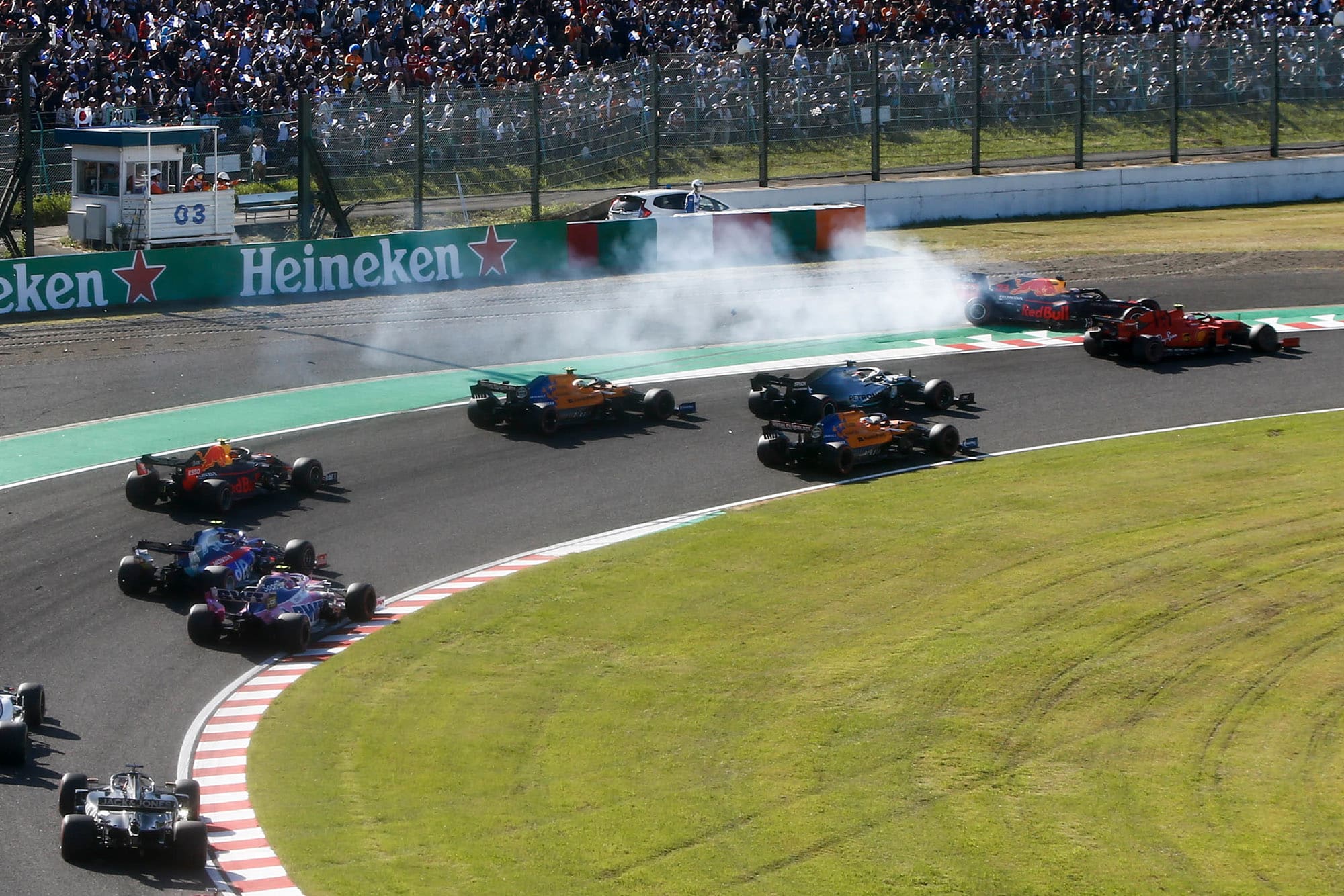
Leclerc collides with Verstappen Photo: Motorsport Images
Hamilton took a hit from Sainz as they raced up the hill towards the Esses, a piece of McLaren endplate a casualty against the Merc, which stayed ahead. Verstappen rejoined at the back with serious floor damage and would soon enough call it a day. Ferrari called Leclerc in for a new nose but he railed against the instruction, reasoning that the car felt ok despite how it looked. Hamilton was asking why the Ferrari was allowed to stay out given the debris shower it was trailing. Leclerc’s endplate eventually disintegrated entirely down the straight to 130R, taking off one of Hamilton’s mirrors as it flew back in the airstream.
The stewards took a dim view of Leclerc continuing with such obvious damage and instructed his team to bring him in. It did so, but he continued for another lap regardless before pitting on the third lap for a new nose and a set of mediums to replace his softs. He’d later receive two time penalties totalling 15sec, one for causing the collision, another for continuing after being instructed to pit for damage.
Bottas was up and away, edging out immediate distance on Vettel. “There was just no way we could live with them,” regretted Seb. The Mercedes were just outright quicker in the race, their 0.2sec deficit from qualifying disappearing with the engines in race modes, leaving the Mercedes’ greater downforce to look after the tyres better and with no real gusts to disturb them.
Bottas was further helped by the delay Hamilton had suffered behind the limping Leclerc. By the time Leclerc pitted Hamilton was already 5sec adrift of the leader.
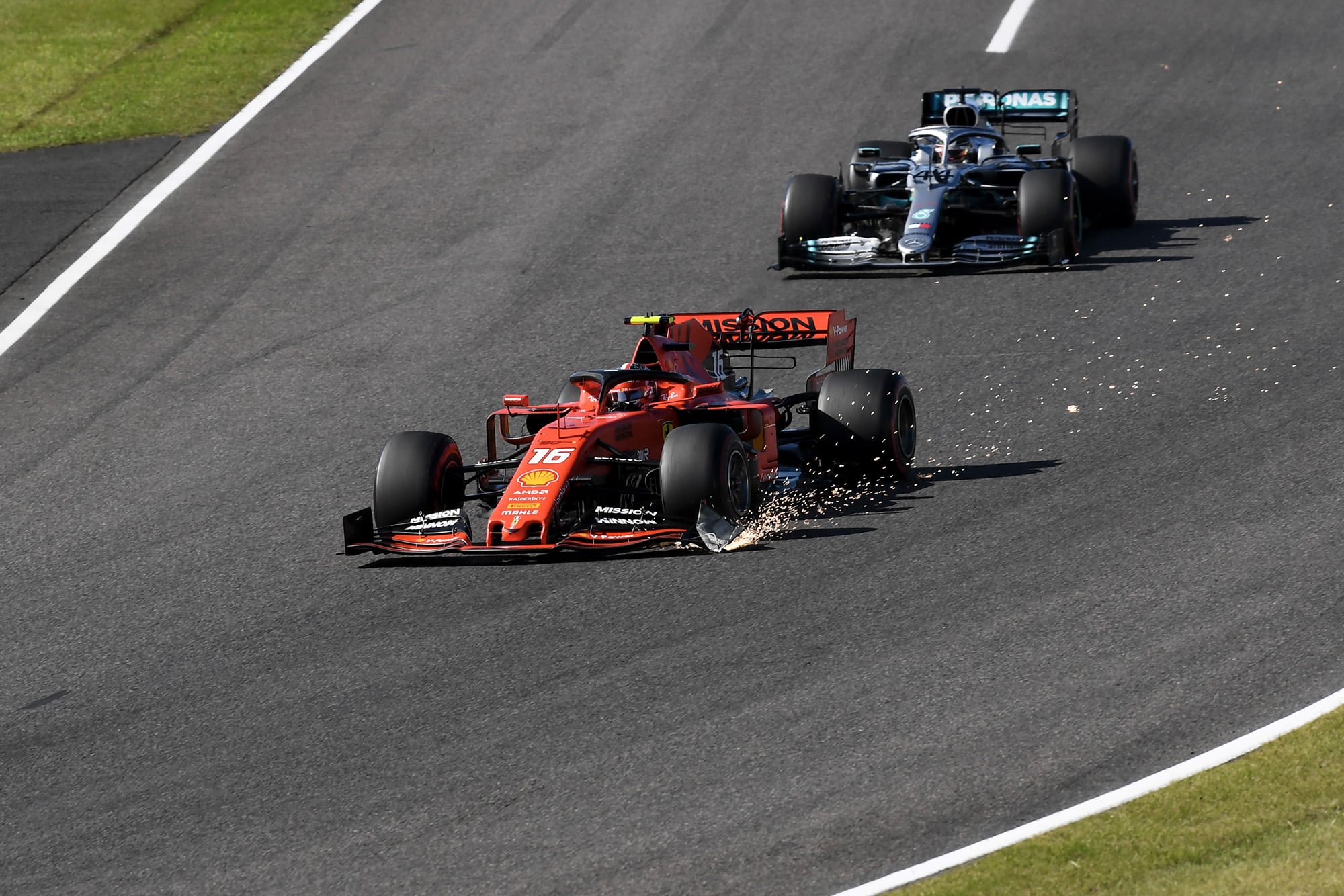
Leclerc debris destroyed Hamilton’s wing mirror and cost him sixth place Photo: Motorsport Images
Ferrari and Red Bull had come into the race certain that it was a two-stop. Mercedes was less convinced. But it soon became clear that the cleansing the circuit had taken from the overnight storm had made the tyre deg very aggressive. Mercedes at this stage could afford the luxury of backing Bottas off, trying to extend his first stint as long as possible, and always with the pace in hand to stay out of Vettel’s undercut range. It was still ambivalent about the one- or the two-stop. For Hamilton, the tentative plan had been a one-stop – so long as the softs didn’t begin degrading beyond a certain point.
Behind the lead quartet, Sainz led the way, initially followed by team-mate Norris. But on the fourth lap, Albon came from a long way behind under braking for the chicane and Norris seemed surprised to find him there as he turned in. They touched and clattered across the run-off area but the McLaren was damaged and Norris made straight for the pits for repairs, rejoining at the back.
Albon continued and closed up on Sainz. Gasly, Stroll, the fast-starting Hülkenberg and Perez followed in close formation. Giovinazzi led the Haas pair of Magnussen and Grosjean, the latter disbelieving of how little grip he had off the line. “Kevin was past me by Turn One and he’d started nine places behind,” he rued. In Grosjean’s wake ran Räikkönen, the advancing Ricciardo (who’d soon be up with Perez), Kvyat (losing time with a gearbox synching problem), with the soon-to-retire Verstappen running ahead only of Russell and the pit lane-starting Kubica.
Related content
Even running with his engine modes trimmed back, Bottas was pulling out time over Vettel who could feel his softs beginning to suffer from as early as the sixth lap. From over 3sec behind, Hamilton – on higher modes than Bottas at this point – began to close the Ferrari down. By the 14th lap Hamilton was within undercut range. Mercedes was tempted, but at this point was still thinking in terms of trying to one-stop Hamilton. It might not have made that decision if it didn’t already have its race-winning options covered by Bottas. In hindsight, an aggressive nailed-on two-stop would have served Hamilton better and he’d have undercut Vettel at around about this point.
Instead, Ferrari brought in Vettel from around 7sec behind Bottas on the 16th lap. The fitment of another set of softs confirmed he was two-stopping. Because the degradation rate of the tyres was so high, the new tyres therefore so much faster than the old, Mercedes couldn’t afford to leave Bottas out for more than another lap. At his stop a set of mediums were fitted, leaving his strategic options open. Vettel had exited behind Sainz and although he passed the McLaren on his out-lap, it had cost him time, increasing Bottas’ advantage over him to around 10sec.
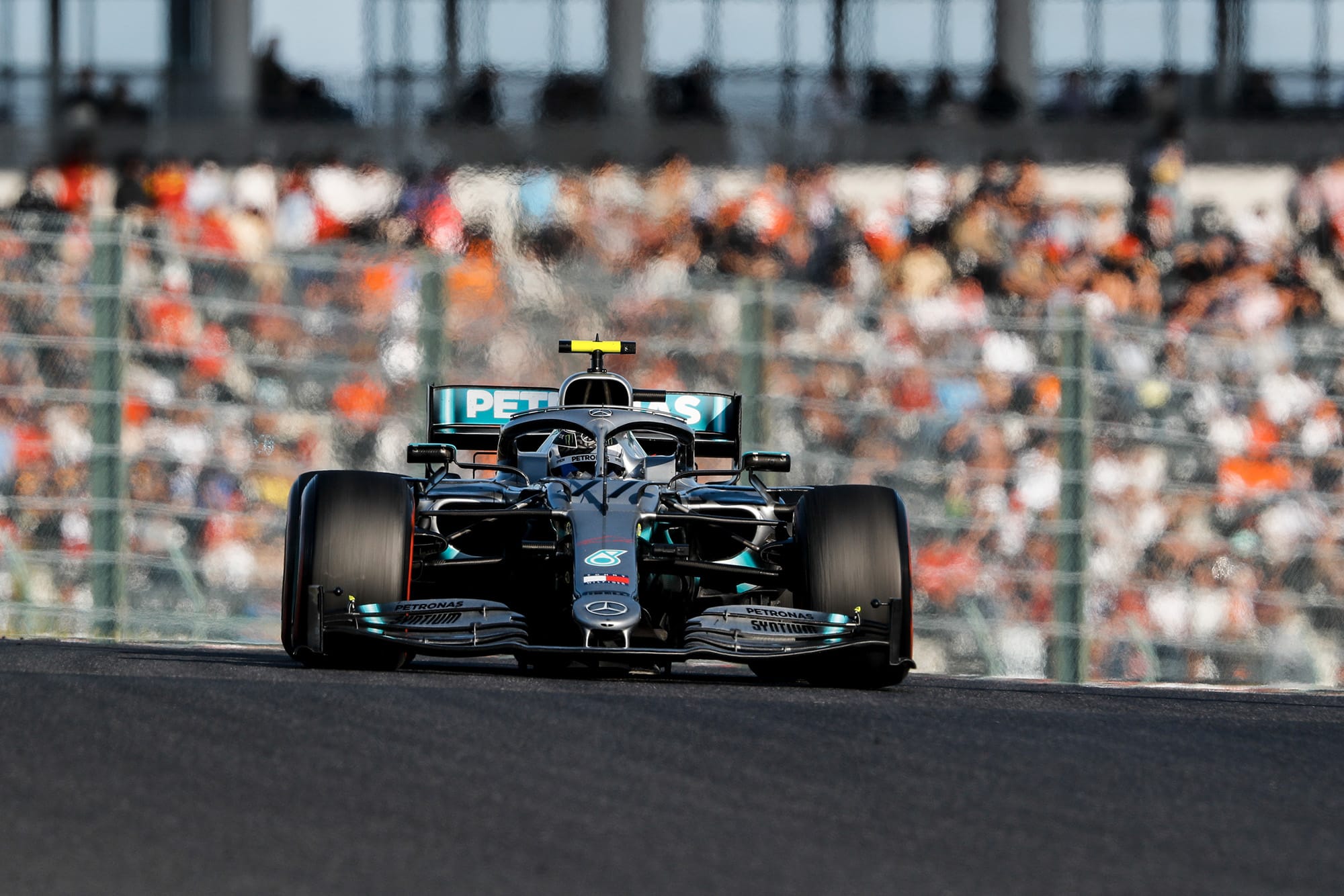
Bottas comfortably ahead Photo: Motorsport Images
Hamilton now led on old tyres, lapping around 3sec slower than Bottas who would be set to catch him within three or four laps. It became very obvious by around lap 19 that Hamilton’s softs were close to the end of their life. The wear rate was confirmed by how little rubber had been left on Bottas’ discarded tyres. With a 53-lap race distance, a medium tyre that lasted only a couple of laps longer than the soft – and a very slow hard compound – it essentially forced Mercedes onto a two-stop with both cars.
“Are you sure Lewis will be stopping?” asked wary Bottas, perhaps casting his mind back to Silverstone
Hamilton was in on the 21st lap for his fresh mediums. The extra four laps had cost him a lot of time to Bottas and he was dismayed to find his distant third place was now 21sec behind the lead, 10sec adrift of Vettel. “That’s it then. I’m basically out of the race. Why didn’t you put me on hards?” he asked. Because they were too slow was the essence of the answer.
Albon had not been able to find a way by Sainz’s faultless defence and came in for the undercut on the 15th lap, with the McLaren staying out there for many laps yet, comfortably dominating ‘Class B’ but ultimately rejoining well behind the Red Bull.
Behind them was a tight little scrap featuring Gasly, Stroll, Hülkenberg, Ricciardo and Perez. Of this group, only Ricciardo had started on mediums and so he’d be running a much longer first stint than the rest of them. He rejoined 10sec adrift of them but on softs as they switched to mediums, he’d be with them soon enough – and ready to begin a spectacular charge.
Leclerc meanwhile was well into his recovery drive from the early stop. His favourite passing place was into Spoon corner but he made a breathtaking pass on Räikkönen’s Alfa down the inside of 130R, wheels almost touching as he turned in. After making a stop for new rubber on the 25th lap, he had much of that passing to do all over again. “The car felt a little strange,” he reported. “It was lacking a bit of front end but I got used to it and wasn’t losing that much lap time actually.” Despite his early delay, he comfortably had the pace to scythe past that Gasly-led group.
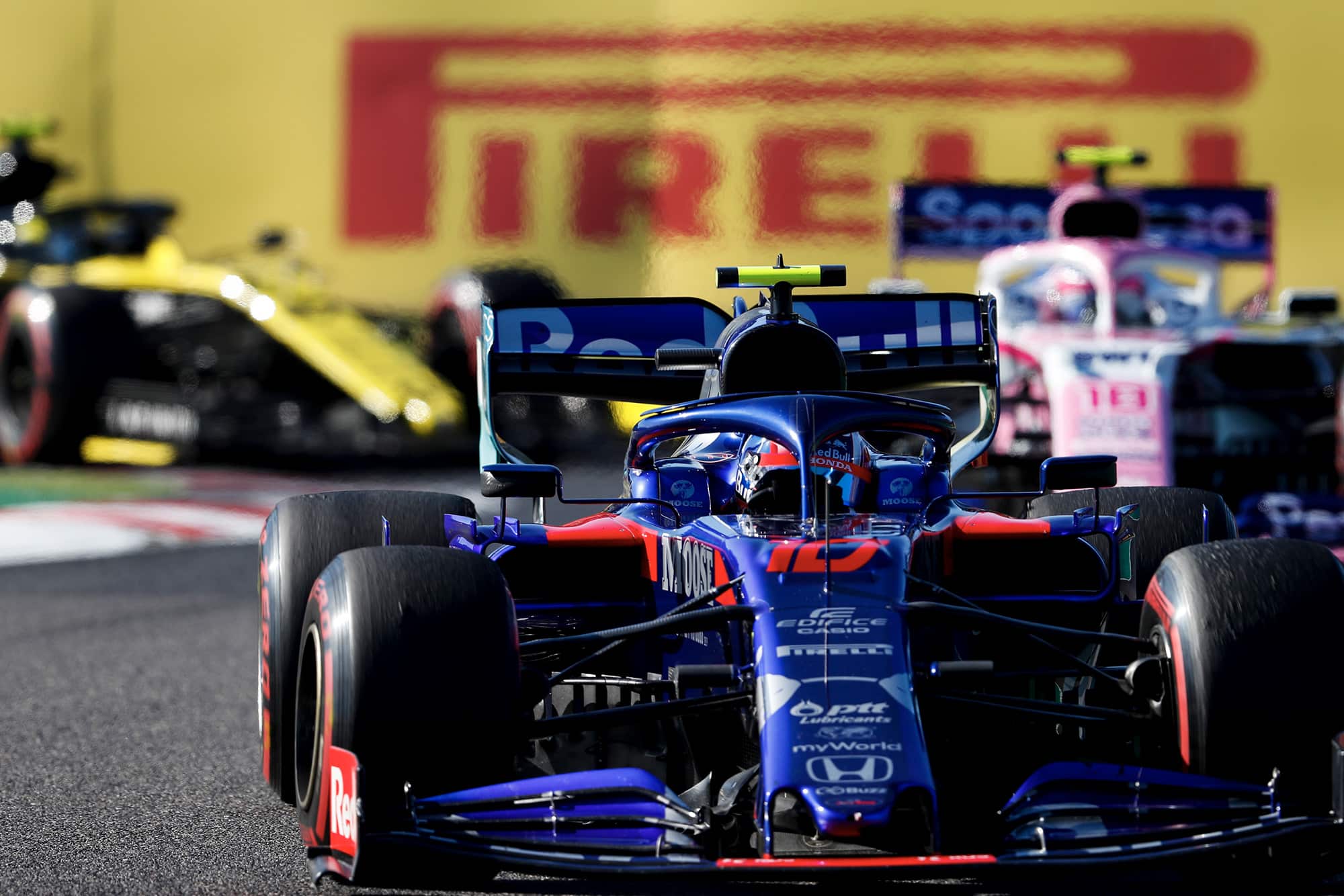
Gasly, Stroll and Hülkenberg in the heat of battle Photo: Motorsport Images
Bottas was never anything other than totally in command and in the middle stint simply maintained his 10-11sec gap over Vettel who was being hunted down all over again by Hamilton. “I think with better guidance I could have done a one-stop to beat Seb,” related Hamilton later. “I’d have had to have driven differently in that second stint, stretched it out as far as I could…” Instead he was using up his rubber just to close down the gap to the Ferrari.
The timing of Vettel’s second stop was determined by the gaggle of traffic he was about to lap, Ferrari bringing him in on lap 31. The medium-shod Mercedes were able to stay out longer, Bottas coming in on lap 36, putting Hamilton into a temporary lead. “I did think about staying out at this point,” admitted Hamilton, “but by that time I’d already pushed so much to close the gap to Seb.”
Before stopping he was around 8sec clear of the just-pitted Bottas. “Are you sure Lewis will be stopping?” asked wary Bottas, perhaps casting his mind back to Silverstone. “Yes,” he was told. “He will definitely stop again.” Even if Hamilton had stayed out there was no way, in the remaining 12 laps he’d have been able to hang onto the lead given how great the tyre deg was. He’d soon have been losing up to 3sec a lap to his newer-tyred team-mate who would have passed with ease.
But might he have been able to fend off Vettel, who still trailed Bottas by around 10sec? It looked feasible, but it would have been a pretty desperate struggle in the last few laps. Instead, Mercedes decided to pit him for a set of softs on the 42nd lap, in the knowledge he’d come out just 3sec behind on much faster rubber with 11 laps still to go. That sounded perfectly do-able, but reckoned without the Ferrari’s prodigious straighline speed and Vettel’s tenacity in using that to stay ahead.
“I was quite slow in the corners and very fast on the straights,” recalled Vettel, “so I just tried to play my advantage and that worked. I’m sure that Lewis didn’t enjoy that as much.” As they came to lap Hülkenberg on the 50th lap between the hairpin and Spoon, it fell awkwardly for Vettel and allowed Hamilton to be almost touching the back of the Ferrari as they exited onto the back straight. But even with the Mercedes in full deployment mode and DRS engaged, it was just 2.5 km/h faster at the end of the straight – not enough to be in position to do anything. As they slalomed around Gasly down the pit straight, Hamilton got alongside the Ferrari into Turn One, but Vettel remained calm, putting his car in all the right places.
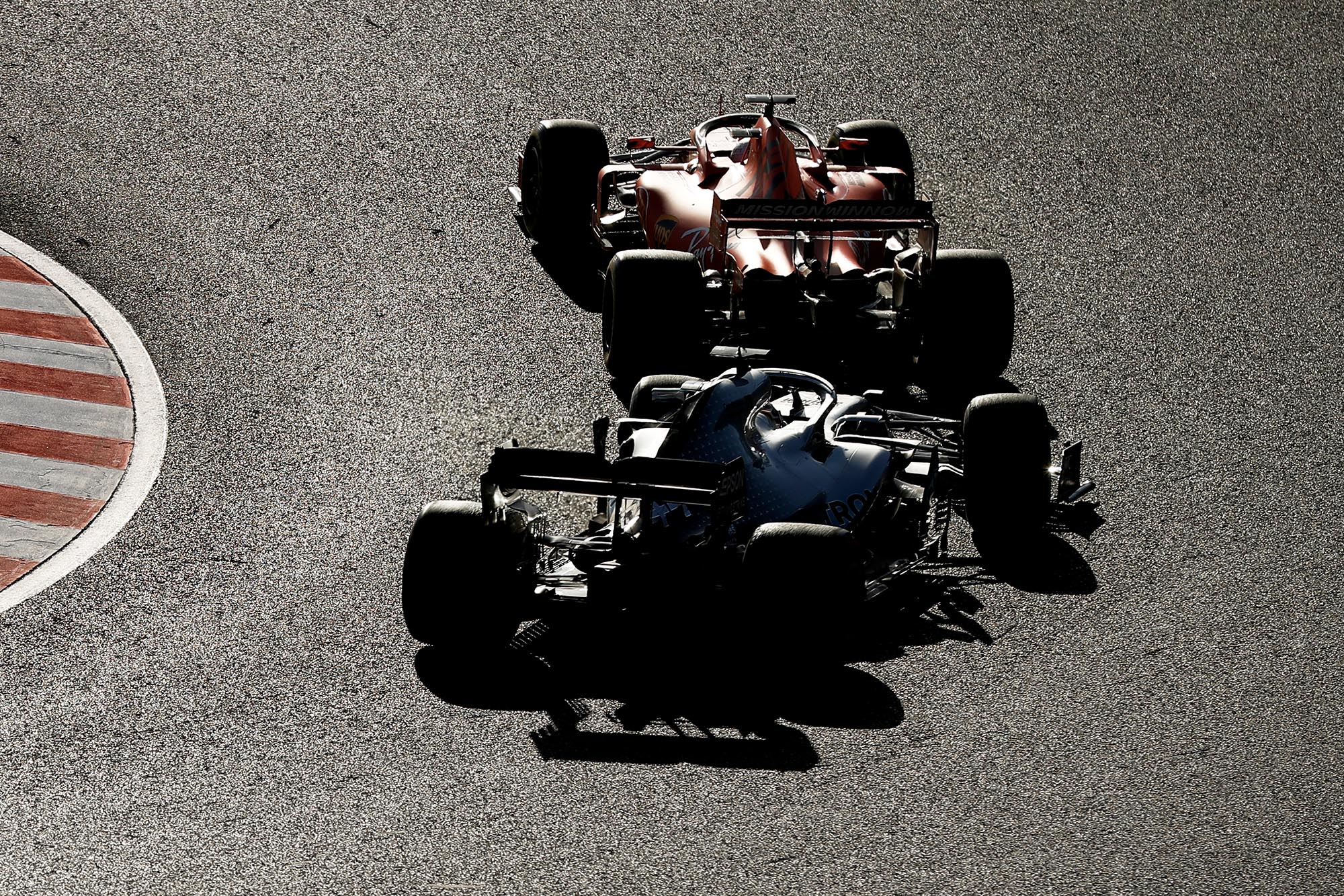
Hamilton came close, but couldn’t pass Vettel Photo: Motorsport Images
Well distant from their struggle, Albon and Sainz completed their lonely but immaculate drives in fourth and fifth respectively. Leclerc’s busy race didn’t see him challenge the top five but he made his way through the Gasly-led midfeld battle and pulled out enough tine on it to make a late third stop for free so as to try for the fastest lap. The plan was thwarted by him coming out a lap behind Bottas, so the fastest lap stat went to Hamilton – enough to confirm Mercedes its constructors title.
That little midfield group comprised mainly early one-stoppers with Gasly, Stroll and Hülkenberg struggling on very old rubber towards the end, making them vulnerable to the late-stopping, soft-shod Ricciardo, courtesy of the latter having eked out his original mediums beautifully. Before he could pass Perez at the back of the group the Racing Point driver converted to a two-stop and rejoined on a set of softs, on which he’d be back up with the group before the end.
Hulkenberg waved his team mate by on the 43rd lap, allowing Ricciardo to set off after Stroll, who he did going into Turn One on the following lap. “It was important I not get bogged down,” recalled Daniel, “and I was trying to ensure I passed everyone as soon as I came up to them.” Next in his sights was Gasly who’d been struggling with a rear suspension problem that was giving the Toro Rosso some very wayward moments. “He really needed his car control in the last few laps,” said an admiring Franz Tost. Ricciardo passed by on the 49th lap to put himself at the head of the group, in seventh place and pulling away.
Stroll was struggling desperately with his rubber, the one-stop having busted and after being passed by (the also one-stopping) Hülkenberg he waved through his new-rubbered recovering team-mate Perez who proceeded to get the upper hand in a dice with Hülkenberg. Entering into the last lap, Perez went for Gasly’s outside into Turn One but the Toro Rosso driver refused to budge. Hard contact ensued and the Racing Point was deposited hard into the barriers.
Except the race had already ended! Someone had inputted the computerised chequered flag into the timing system after 52 laps rather than 53 and so that’s when the results were officially declared. The drivers knew nothing of this and raced on through the phantom 53rd lap to take the actual physical chequer. The error ensured that Perez retained the ninth place he’d been in before his crash, so Hülkenberg and Stroll didn’t get to benefit from having passed him.
Behind Stroll ran the compromised Kvyat, Norris, Räikkönen, Grosjean, Giovinazzi and Magnussen, with Russell and Kubica a further lap down in the two Williams.
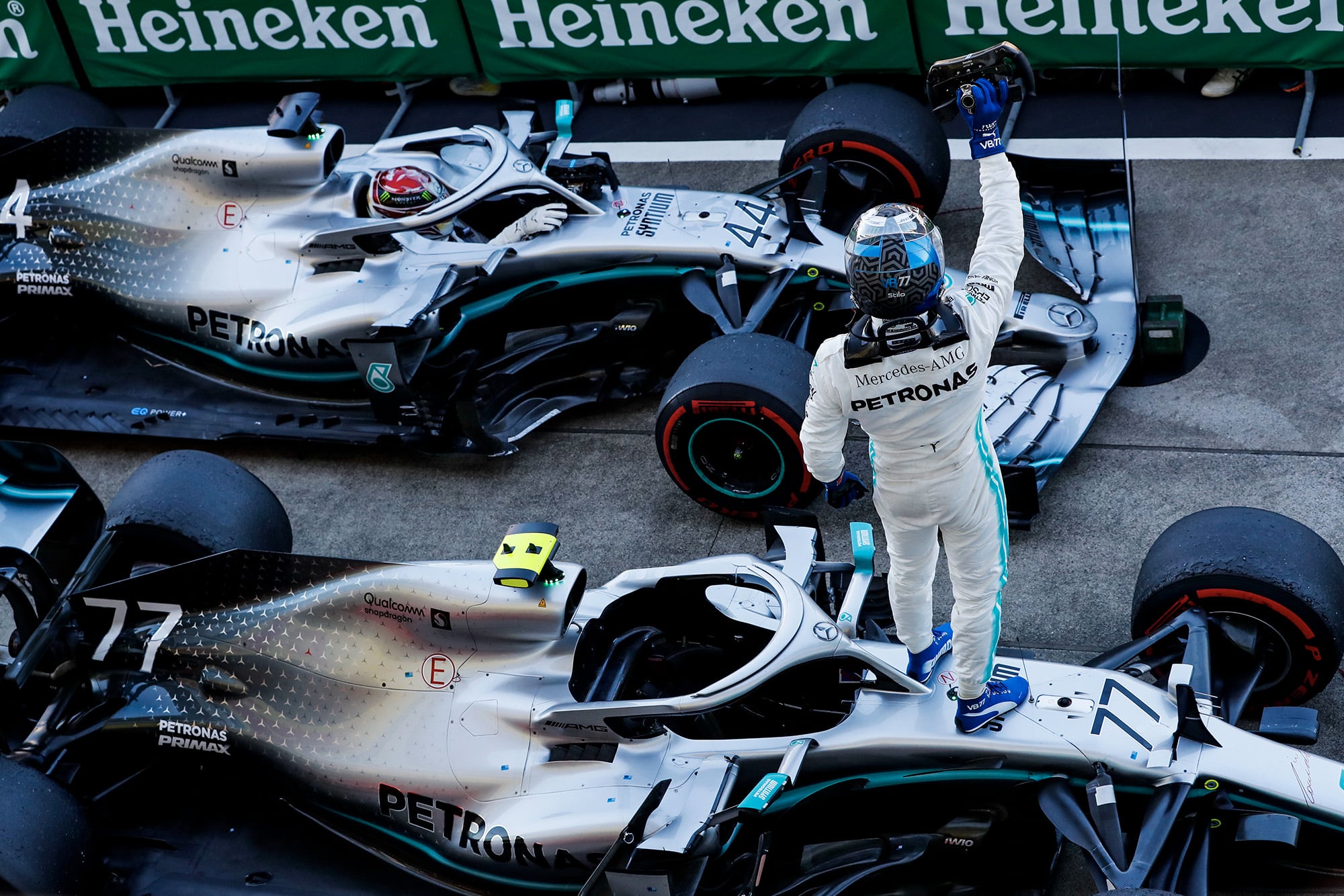
Photo: Motorsport Images
Bottas had never been anything less than fully in control of his destiny in taking his third victory of the year, a result that keeps him in with an outside mathematical chance of the title. Vettel held his nerve and his line for a second place that might’ve been more without that error a fraction of a second before the race began. Leclerc’s 15sec-worth of penalties lost him his sixth place in the official results to Ricciardo.
Bottas wore a quietly satisfied smile up in the green room, accepted the congratulations with his usual humble grace. “It’s always been my favourite circuit,” he said. “But it’s not been a good one for me in terms of results. It’s kind of the favourite that I’ve looked forward to the most in terms of the driving side. So, yeah, for sure now it makes it a more special track for me.”
Vettel could only reflect on the qualities of his opposition as it celebrated that sixth consecutive constructors’ championship. “They are very close to perfection every time they go out on track, very consistent, very little mistakes. That’s certainly part of what makes them so strong but yeah, if you clinch the constructors’ title with four races to go there’s a lot of things you do better than all the others. If you go into detail then you can argue what their car is maybe doing better than ours but I don’t think that’s the point overall; it’s a team effort and I think we do have the ingredients, we do have the commitment, we do have the intelligence, but we just need to do it better.”
| Position | Driver | Team | Time | Points |
|---|---|---|---|---|
| 1 | Valtteri Bottas | Mercedes | 1hr 21min 46.755sec | 25 |
| 2 | Sebastian Vettel | Ferrari | +13.343sec | 18 |
| 3 | Lewis Hamilton | Mercedes | +13.858sec | 16* |
| 4 | Alex Albon | Red Bull | +59.537sec | 12 |
| 5 | Carlos Sainz | McLaren | +1min 9.101sec | 10 |
| 6 | Daniel Ricciardo | Renault | +1 lap | 8 |
| 7 | Charles Leclerc | Ferrari | +1 lap** | 6 |
| 8 | Pierre Gasly | Toro Rosso | +1 lap | 4 |
| 9 | Sergio Perez | Racing Point | +1 lap | 2 |
| 10 | Nico Hülkenberg | Renault | +1 lap | 1 |
| 11 | Lance Stroll | Racing Point | +1 lap | |
| 12 | Daniil Kvyat | Toro Rosso | +1 lap | |
| 13 | Lando Norris | McLaren | +1 lap | |
| 14 | Kimi Räikkönen | Alfa Romeo | +1 lap | |
| 15 | Romain Grosjean | Haas | +1 lap | |
| 16 | Antonio Giovinazzi | Alfa Romeo | +1 lap | |
| 17 | Kevin Magnussen | Haas | +1 lap | |
| 18 | George Russell | Williams | +2 laps | |
| 19 | Robert Kubica | Renault | +2 laps | |
| 20 | Max Verstappen | Haas | DNF |
*Fastest lap
**Includes 15sec penalty
| Position | Driver | Team | Points |
|---|---|---|---|
| 1 | Lewis Hamilton | Mercedes | 338 |
| 2 | Valtteri Bottas | Mercedes | 274 |
| 3 | Charles Leclerc | Ferrari | 223 |
| 4 | Max Verstappen | Red Bull | 212 |
| 5 | Sebastian Vettel | Ferrari | 212 |
| 6 | Carlos Sainz | McLaren | 76 |
| 7 | Pierre Gasly | Toro Rosso | 73 |
| 8 | Alexander Albon | Red Bull | 64 |
| 9 | Daniel Ricciardo | Renault | 40 |
| 10 | Nico Hülkenberg | Renault | 35 |
| 11 | Sergio Perez | Racing Point | 35 |
| 12 | Lando Norris | McLaren | 35 |
| 13 | Daniil Kvyat | Toro Rosso | 33 |
| 14 | Kimi Räikkönen | Alfa Romeo | 31 |
| 15 | Kevin Magnussen | Haas | 20 |
| 16 | Lance Stroll | Racing Point | 19 |
| 17 | Romain Grosjean | Haas | 8 |
| 18 | Antonio Giovinazzi | Alfa Romeo | 4 |
| 19 | Robert Kubica | Williams | 1 |
| 20 | George Russell | Williams | 0 |
| Position | Team | Points |
|---|---|---|
| 1 | Mercedes | 612 |
| 2 | Ferrari | 435 |
| 3 | Red Bull | 323 |
| 4 | McLaren | 111 |
| 5 | Renault | 76 |
| 6 | Toro Rosso | 59 |
| 7 | Racing Point | 53 |
| 8 | Alfa Romeo | 35 |
| 9 | Haas | 28 |
| 10 | Williams | 1 |

Laurent Mekies arrives as Red Bull F1 team principal with a series of immediate challenges to solve and long-term issues to tackle. He'll either sink or swim, says Mark Hughes

Former McLaren F1 team-mates Mika Häkkinen and David Coulthard are set to renew old rivalries in a new Evening with... tour – they told James Elson all about it

In Formula 1, driver contracts may look iron-clad on paper, but history shows that some of its biggest stars have made dramatic early exits

Former McLaren F1 ace told James Elson about his private audience with The Beatles' George Harrison, who played an unreleased grand prix-themed song